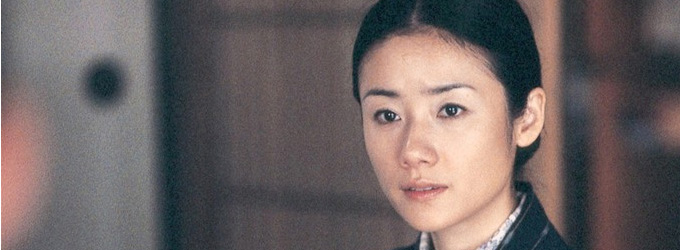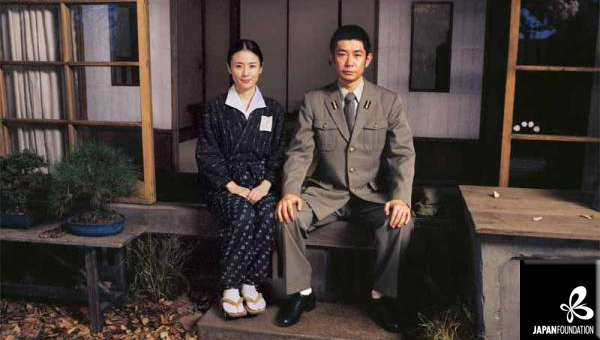 Kazuo Kuroki’s last film, THE BLOSSOMING OF ETSUKO KAMIYA, made just before his death in 2006, is the kind of film that is more than likely to meet whatever expectations you might have when you think of serious Japanese cinema, particularly one that is adapted from a play that looks back at the past and specifically at the war years. It’s formal, sombre, reflective and poetic, and in that respect reminiscent of the post-war films of Yasujiro Ozu. Stylistically, it may have little in common with Ozu’s tatami-mat camera angles, but its straightforward dialogue-driven approach, built around a family situation that uses a few interior home locations, similarly succeeds in the way that it able to evoke a great deal more than is apparent on the surface.
Kazuo Kuroki’s last film, THE BLOSSOMING OF ETSUKO KAMIYA, made just before his death in 2006, is the kind of film that is more than likely to meet whatever expectations you might have when you think of serious Japanese cinema, particularly one that is adapted from a play that looks back at the past and specifically at the war years. It’s formal, sombre, reflective and poetic, and in that respect reminiscent of the post-war films of Yasujiro Ozu. Stylistically, it may have little in common with Ozu’s tatami-mat camera angles, but its straightforward dialogue-driven approach, built around a family situation that uses a few interior home locations, similarly succeeds in the way that it able to evoke a great deal more than is apparent on the surface.
Based on a play by Masataka Matsuda, the film could hardly be more theatrically formal in its approach. Kuroki maintains a setting of only four scenes without any real opening-out of the work. Most of the film takes place in a single room over the period of two significant weeks in the Spring of 1945, and the main body of the work is bookended by a present-day prologue and epilogue. It’s tempting to think that a more cinematic approach might have been attempted without having any apparent detrimental impact on the story, but in reality the film is so tightly structured, so meticulous in its choice of words and its use of imagery, that any attempt to over-illustrate it with superfluous elements would probably only have weakened the delicate balance of interiority that has been so carefully put in place.
“Why am I alive? Why didn’t I die like the others?”
Even the fact that the main element of story is looked back upon from the present day has a purpose. On the surface, the opening is deceptively simple: an elderly lady shown conversing with her sick husband on the roof of a hospital. The sun is setting in a brilliant red sky, as the couple debate whether it is getting too chilly to be sitting there any longer. However mundane the spoken dialogue appears to be, it’s clear that there is deeper poetic resonance here. This is a film that not just about reflection on the past, but it is also about looking ahead to the future, to the unknown, to the hope of what lies “beyond the mountains” that the crimson clouds of the sunset seem to be floating towards. The origin of those sentiments is revealed as the old man, Nagamasa, perhaps mindful of approaching the end of his life, reflects back on the war and asks a question that has significance not just for himself, but to a whole generation. “Why am I alive? Why didn’t I die like the others?”
The main part of the drama takes place in the Spring of 1945, and some of the explicit references that are made gain extra significance because of its relevance to the present-day and the hindsight it provides. On the surface, the story remains simple, related to a marriage proposal that has been made to Etsuko Kamiya (Tomoyo Harada), a young woman who is living with her elder brother Yatsutada and his wife Fusa in the remote village of Komentsu in the Kagoshima prefecture, her parents having died during the air raids on Tokyo. Etsuko is surprised and clearly a little disappointed that the marriage proposal hasn’t come from Mr Akashi (Shunsuke Matsuoka), a pilot in the Japanese airforce with whom she is clearly in love, but has actually been made by him on behalf of a friend, Nagayo (Masatoshi Nagase), a humble mechanic.
… complex unspoken resonances in the contradiction of happiness being found in a time of sorrow …
Amidst much formal ceremony of the visits by Akashi and Nagayo to the Kamiya household, including preparations of food and serving of tea, the weight of circumstances are revealed in a way we would only recognise as being significant from a present-day perspective. The setting of the story during a time when the unthinkable likelihood of Japan losing the war was apparent if not openly acknowledged, consequently takes on greater significance; as do references to Nagayo’s hometown of Nagasaki and the revelation that Akashi is about to leave to take part in the battle of Okinawa. As a pilot in the Japanese airforce, that only leaves one possible outcome, and it explains and adds poignancy to his reasons for suggesting another match for Etsuko and for his behaviour during the visit to her household.
The film can only bear so much weighty resonance, however indirectly suggested, but it balances this with a much more delicate, poetic and at times even humorous approach in the awkwardness of the encounters that, notwithstanding the nature of the war, reflects the beauty of living in the moment. Etsuko can hear the sound of waves – even though the village is far from the sea – and the petals of the cherry blossom that has only just burst into full bloom are already beginning to fall. THE BLOSSOMING OF ETSUKO KAMIYA gathers up all these poetic references and contrasting undercurrents in a way that is utterly Japanese in character, creating complex unspoken resonances in the contradiction of happiness being found in a time of sorrow, on the sadness of the transitory nature of life, and the beauty that is found even in its decline.
Those resonances are found even within the structure of the work itself, and in how it addresses and acknowledges the past from the present. Looking at a cherry tree in the present – with everything that this iconic image represents to the nation of Japan and as a representation of nature and change – can’t help but forge a direct connection to the past. Looking out towards the ocean that may lie beyond the mountains in the present day, the film also reflects on how those events in the past have shaped and still hold tremendous influence over modern-day Japan and its outlook for the future.
Reinventing the Past Through the Eyes of Japanese Contemporary Filmmakers
Marking its 10th anniversary, the Japan Foundation Touring Film Programme looks back into the past through the eyes of contemporary filmmakers. Touching upon a trend prevalent in recent Japanese cinema, this season showcases a series of works from directors including Takashi Miike, Sunao Katabuchi, Hirokazu Kore-eda and Isshin Inudo, who all share the same aspiration to reinterpret and relive moments of times gone by through a variety of genres, styles and tones. The programme began on 1 February 2013 and its nationwide tour runs until 27 March 2013.

